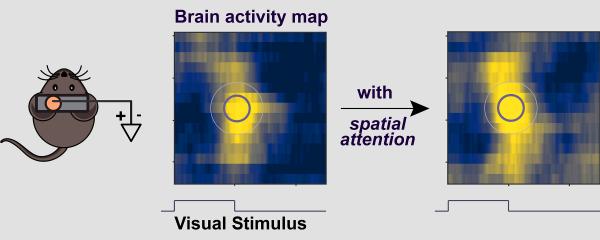Spatial attention is what happens when we selectively focus on a region in our visual field and quickly extract information from the scene. When you look for your friend with the yellow hat in the upper deck of the arena, and you filter out all the other yellow caps to find him, you’re utilizing spatial attention.
At least, that’s how it works in a healthy brain. For people with a range of disparate ailments – autism spectrum disorders, attention deficit disorders, or schizophrenia, for example – finding the friend in the yellow hat isn’t all that simple. And so, understanding the role of attention in sensory perception is a critical component of neuro research, and ultimately, in the future development of better diagnostic tests or treatments, and also for the enhancement of normal attention.
With all of that in mind, Georgia Institute of Technology researcher Bilal Haider and his team are meticulously investigating the brain circuits and mechanisms underlying visual spatial attention, utilizing transgenic mice, publishing their most recent findings in the online journal, Nature Communications, with an article entitled, “Spatial attention enhances network, cellular and subthreshold responses in mouse visual cortex.”
“We figured out how to control and measure visual attention in the mouse brain,” said Haider, assistant professor in the Wallace H. Coulter Department of Biomedical Engineering (BME) at Georgia Tech and Emory University (BME), and a researcher in the Petit Institute for Bioengineering and Bioscience at Georgia Tech.
“We then found that attention to a point in space quickly causes widespread enhancement of neural responses to both faint and bright visual stimuli at that location – just like increasing the volume amplifies all the details in the music, not just the vocals,” explained Haider.
The latest work builds on his lab’s previous research, which showed that mice are an excellent model system for studying how neural circuits mediate visual behavior, providing a useful platform for studying what happens when humans make fast decisions – or when they don’t – about visual information.
“This paper sets us up to identify the neural circuits underlying these attentional effects using genetic technologies easily exploitable in mice, and also to investigate attention deficits in mouse models of neurological disease,” said Haider, whose collaborators/co-writers were lead author Anderson Speed (BME graduate student), Joseph Del Rosario (BME grad student), and Navid Mikail (former BME undergraduate researcher in Haider’s lab).
The research was funded by the Whitehall Foundation, Sloan Foundation, GT Neural Engineering Center, NIH NINDS (1R01NS107968), and NIH BRAIN Initiative (1R01NS109978).
Media Contact
Jerry Grillo
Communications Officer II
Parker H. Petit Institute for
Bioengineering and Bioscience
Keywords
Latest BME News
Jo honored for his impact on science and mentorship
The department rises to the top in biomedical engineering programs for undergraduate education.
Commercialization program in Coulter BME announces project teams who will receive support to get their research to market.
Courses in the Wallace H. Coulter Department of Biomedical Engineering are being reformatted to incorporate AI and machine learning so students are prepared for a data-driven biotech sector.
Influenced by her mother's journey in engineering, Sriya Surapaneni hopes to inspire other young women in the field.
Coulter BME Professor Earns Tenure, Eyes Future of Innovation in Health and Medicine
The grant will fund the development of cutting-edge technology that could detect colorectal cancer through a simple breath test
The surgical support device landed Coulter BME its 4th consecutive win for the College of Engineering competition.









